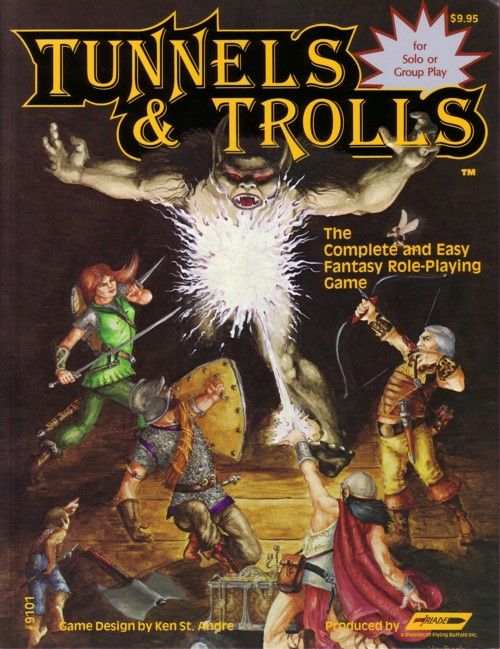10 Things About 5th Edition Tunnels & Trolls that are Old School
Thursday , 18, August 2016 Appendix N, Tabletop Games 3 Comments
- The only people its creators had to worry about offending was the legal department at TSR.
- There are no rules for demi-human special abilities such as elves with keen hearing, dwarves that can very nearly smell gold, and hobbits that are good at stealth. All of this sort of thing is covered by the “verbal give-and-take between the Game Master and the players.”
- The rogue character type is more of an outsider or loose canon than some sort of low rate thug or sneak-thief. The title has as much to do with the fact that they learn magic outside of the usual guild system as anything else.
- Character creation pretty much boils down to rolling 3d6 in order, picking a character type, and selecting starting equipment. There’s no skills or proficiency systems here: if you want to develop your character, you have to go live through some adventures. If you don’t like how character creation is set up, you can fit your own variant system on an index card.
- The six “prime attributes” define most everything significant about a character and nearly everything not addressed by the combat and spell rules is covered by attribute-based “saving rolls”. (It’s as if someone struggled to comprehend that other game’s oddly specific “prime requisite” rules and byzantine “saving throw” systems and then came up what’s essentually the ur-GURPS in order to avoid having to deal with them.)
- Monsters only require a single number in order to stat them up. If you wanted to make up an entirely new bestiary for your game, it can fit on a half sheet of paper. (Ken St. Andre’s monster list is provided, but it’s merely give you an idea of how it’s done and not really meant to be some sort of canon you have to slavishly adhere to.)
- Spells can be described with a couple of numbers and a sentence or two. If you wanted to work up a variant spell system, you could easily fit an entire level’s worth of spells on a single page. Wizard characters that reach the 5th level can create new spells without any sort of wonky magical engineering rules– the only limitation is that the other players have to agree to its incorporation into the campaign.
- The combat rules are simpler than you might guess… but somehow, I discover something new about them every time I revisit them. (Certainly, the examples presented here are very different from how I’ve interpreted the other editions I’ve played.) The rules are also intentionally uncomprehensive. Instead of tedious and voluminous game mechanics, “the GM and players are urged to use their own creativity, imagination, and good sense to unravel difficult dilemmas.”
- An elaborate setting is not needed to begin play. Rather than purchasing somebody else’s world, you are instead strongly urged to create your own. There is no extensive module series for the game, either, but the Game Master is– by definition here– “digging” and stocking an “enchanted tunnel complex” in order to get a game off the ground.
- For inspiration in monster creation, the Game Master is directed to “mythologies of ancient cultures, or books of science fiction and heroic fantasy.” For inspiration in world building, the Game Master is told that “any scenario, any piece of fiction or non-fiction can be mined for enjoyment– from Sherlock Holmes to Kipling’s Mowgli, from Classical Greece to the African Veldt….” Warriors are explicitly based on Robert E. Howard’s Conan. Wizards are based on Tolkien’s Gandalf or Merlin of Arthur’s England. Rogues are based on Fritz Leiber’s Grey Mouser or Jack Vance’s Cugel the Clever. Alternate Humanoid Characters can include everything from de Camp’s Daemons to Lovecraft’s Ghouls. And if you want to send these characters “into the future of the Wild West, or further yet into the space-faring world of Buck Rogers or Captain Kirk”, that’s perfectly in keeping with the spirit of the game.
And you were encourage to run your own rat-on-a-stick franchise!
This sounds fun. If I another chance to DM in the future (in other words meet people with the time and desire to play), I’d love to try something like this. As much as I appreciated the structure of D&D 3.5, it was easy to get lost in rules and numbers sometimes. A system with looser rules and more DM/player discrepancy on what is possible would be a welcome change for me.
The low-fi vibe with T&T has always appealed to me and I have a few editions of the rules. I have not been able to give it a real go though. Hard to find players around here. Me and a bud played a bit semi-solo, trying to get through Buffalo Castle, and I ran him through a mini dungeon. It seems like something that you really need a big, fun group to play with to appreciate it properly.